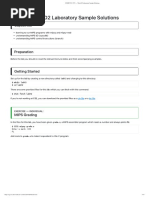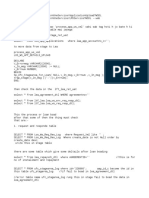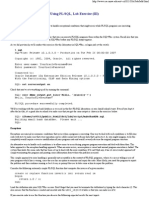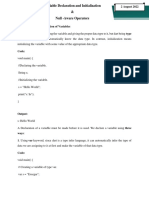Chapter 13 How to create Store Procedures and Functions Lab 1
Uploaded by
sak471725Chapter 13 How to create Store Procedures and Functions Lab 1
Uploaded by
sak471725ROYAL UNIVERSITY OF PHNOM PENH
DATABASE II
Chapter 13
How to create stored procedures and functions (Lab)
Lecturer: Mr. Chhim Bunchhun,
chhim.bunchhun@rupp.edu.kh, 093 222 380
A stored procedure that displays a message
DELIMITER //
CREATE PROCEDURE test()
BEGIN
SELECT 'This is a test.' AS message;
END//
CALL test();
The response from the system
Chapter 13 How to create stored procedures and functions 2
A script that creates and calls a stored procedure
USE ap;
DROP PROCEDURE IF EXISTS test;
-- Change statement delimiter from semicolon to double front slash
DELIMITER //
CREATE PROCEDURE test()
BEGIN
DECLARE sum_balance_due_var DECIMAL(9, 2);
SELECT SUM(invoice_total - payment_total - credit_total)
INTO sum_balance_due_var
FROM invoices
WHERE vendor_id = 95;
Chapter 13 How to create stored procedures and functions 3
A script that creates and calls a stored procedure (continued)
IF sum_balance_due_var > 0 THEN
SELECT CONCAT('Balance due: $', sum_balance_due_var) AS message;
ELSE
SELECT 'Balance paid in full' AS message;
END IF;
END//
-- Change statement delimiter from double front slash to semicolon
DELIMITER ;
CALL test();
The response from the system
Chapter 13 How to create stored procedures and functions 4
A stored procedure that uses variables
DELIMITER //
CREATE PROCEDURE test()
BEGIN
DECLARE max_invoice_total DECIMAL(9,2);
DECLARE min_invoice_total DECIMAL(9,2);
DECLARE percent_difference DECIMAL(9,4);
DECLARE count_invoice_id INT;
DECLARE vendor_id_var INT;
SET vendor_id_var = 95;
SELECT MAX(invoice_total), MIN(invoice_total),
COUNT(invoice_id)
INTO max_invoice_total, min_invoice_total,
count_invoice_id
FROM invoices WHERE vendor_id = vendor_id_var;
Chapter 13 How to create stored procedures and functions 5
A stored procedure that uses variables (cont.)
SET percent_difference =
(max_invoice_total - min_invoice_total) /
min_invoice_total * 100;
SELECT CONCAT('$', max_invoice_total) AS 'Maximum invoice',
CONCAT('$', min_invoice_total) AS 'Minimum invoice',
CONCAT('%', ROUND(percent_difference, 2)) AS 'Percent difference',
count_invoice_id AS 'Number of invoices';
END//
The response from the system
Chapter 13 How to create stored procedures and functions 6
A stored procedure that uses an IF statement
DELIMITER //
CREATE PROCEDURE test()
BEGIN
DECLARE first_invoice_due_date DATE;
SELECT MIN(invoice_due_date)
INTO first_invoice_due_date
FROM invoices
WHERE invoice_total - payment_total - credit_total > 0;
IF first_invoice_due_date < NOW() THEN
SELECT 'Outstanding invoices are overdue!';
ELSEIF first_invoice_due_date = NOW() THEN
SELECT 'Outstanding invoices are due today!';
ELSE
SELECT 'No invoices are overdue.';
END IF;
END//
The response from the system
Chapter 13 How to create stored procedures and functions 7
A stored procedure with a simple CASE statement
DELIMITER //
CREATE PROCEDURE test()
BEGIN
DECLARE terms_id_var INT;
SELECT terms_id INTO terms_id_var
FROM invoices WHERE invoice_id = 4;
CASE terms_id_var
WHEN 1 THEN
SELECT 'Net due 10 days' AS Terms;
WHEN 2 THEN
SELECT 'Net due 20 days' AS Terms;
WHEN 3 THEN
SELECT 'Net due 30 days' AS Terms;
ELSE
SELECT 'Net due more than 30 days' AS Terms;
END CASE;
END//
The response from the system
Chapter 13 How to create stored procedures and functions 8
A stored procedure that uses a WHILE loop
DELIMITER //
CREATE PROCEDURE test()
BEGIN
DECLARE i INT DEFAULT 1;
DECLARE s VARCHAR(400) DEFAULT '';
WHILE i < 4 DO
SET s = CONCAT(s, 'i=', i, ' | ');
SET i = i + 1;
END WHILE;
SELECT s AS message;
END//
The output for this code
Chapter 13 How to create stored procedures and functions 9
A stored procedure that uses a cursor
DELIMITER //
CREATE PROCEDURE test()
BEGIN
DECLARE invoice_id_var INT;
DECLARE invoice_total_var DECIMAL(9,2);
DECLARE row_not_found TINYINT DEFAULT FALSE;
DECLARE update_count INT DEFAULT 0;
DECLARE invoices_cursor CURSOR FOR
SELECT invoice_id, invoice_total FROM invoices
WHERE invoice_total - payment_total - credit_total > 0;
DECLARE CONTINUE HANDLER FOR NOT FOUND
SET row_not_found = TRUE;
OPEN invoices_cursor;
WHILE row_not_found = FALSE DO
FETCH invoices_cursor INTO invoice_id_var, invoice_total_var;
Chapter 13 How to create stored procedures and functions 10
A stored procedure that uses a cursor (continued)
IF invoice_total_var > 1000 THEN
UPDATE invoices
SET credit_total = credit_total + (invoice_total * .1)
WHERE invoice_id = invoice_id_var;
SET update_count = update_count + 1;
END IF;
END WHILE;
CLOSE invoices_cursor;
SELECT CONCAT(update_count, ' row(s) updated.');
END//
The response from the system
Chapter 13 How to create stored procedures and functions 11
THANK YOU
for your attention !
You might also like
- COMP1521 22T1 - Week 02 Laboratory Sample Solutions100% (1)COMP1521 22T1 - Week 02 Laboratory Sample Solutions17 pages
- MySQL Stored Procedure Function Lecture Notes ContinuationNo ratings yetMySQL Stored Procedure Function Lecture Notes Continuation6 pages
- SA0951a Oracle Practical: PL/SQL Cursors, Procedures, FunctionsNo ratings yetSA0951a Oracle Practical: PL/SQL Cursors, Procedures, Functions7 pages
- PL/SQL Questions: 2. Implicit Cursors Are Used For SQL Statements That Are Not NamedNo ratings yetPL/SQL Questions: 2. Implicit Cursors Are Used For SQL Statements That Are Not Named5 pages
- Advanced SQL: Stored Procedures: Instructor: Mohamed Eltabakh Meltabakh@cs - Wpi.eduNo ratings yetAdvanced SQL: Stored Procedures: Instructor: Mohamed Eltabakh Meltabakh@cs - Wpi.edu23 pages
- L 23 Introduction To PLSQL and Stored ProceduresNo ratings yetL 23 Introduction To PLSQL and Stored Procedures32 pages
- TP3 Structures de contrôle zineb chadiliNo ratings yetTP3 Structures de contrôle zineb chadili8 pages
- System System - Collections.Generic System - Text Bank (: Using Using Using NamespaceNo ratings yetSystem System - Collections.Generic System - Text Bank (: Using Using Using Namespace11 pages
- Mark Trigger With PRAGMA AUTONOMOUS - TRANSACTION - Trigger and Transaction Trigger Oracle PL - SQL TutorialNo ratings yetMark Trigger With PRAGMA AUTONOMOUS - TRANSACTION - Trigger and Transaction Trigger Oracle PL - SQL Tutorial2 pages
- Oracle 11G PL SQL Programming 2nd Edition Casteel Solutions Manual all chapter instant download100% (9)Oracle 11G PL SQL Programming 2nd Edition Casteel Solutions Manual all chapter instant download45 pages
- Example 1-1 Declaring Variables in PL/SQL: Bonus NUMBER (8,2)No ratings yetExample 1-1 Declaring Variables in PL/SQL: Bonus NUMBER (8,2)23 pages
- How To Create A Manual Transaction and Pay Commission in Oracle Incentive Compensation Release 12 (ID 1248974.1)No ratings yetHow To Create A Manual Transaction and Pay Commission in Oracle Incentive Compensation Release 12 (ID 1248974.1)6 pages
- Oracle PL-SQL Fundamentals Part 2 Practise QueriesNo ratings yetOracle PL-SQL Fundamentals Part 2 Practise Queries7 pages
- Service Programs and Unit Testing the Perfect PairNo ratings yetService Programs and Unit Testing the Perfect Pair45 pages
- SLA Oracle Order Management DistributionNo ratings yetSLA Oracle Order Management Distribution17 pages
- Understanding Software Engineering Vol 3: Programming Basic Software Functionalities.From EverandUnderstanding Software Engineering Vol 3: Programming Basic Software Functionalities.No ratings yet
- React Architecture Patterns for Your ProjectsNo ratings yetReact Architecture Patterns for Your Projects24 pages
- Le Nguyễn Gia Phúc - B2206002 - CT104H - Ab3No ratings yetLe Nguyễn Gia Phúc - B2206002 - CT104H - Ab312 pages
- Jwt Magazine December 2024_Compress (1)No ratings yetJwt Magazine December 2024_Compress (1)125 pages
- Advance Java Script Coding Questions With AnswerNo ratings yetAdvance Java Script Coding Questions With Answer6 pages
- Altcademy S Back-End Web Development SyllabusNo ratings yetAltcademy S Back-End Web Development Syllabus10 pages
- Notes Lecture 9 Variable Declaration and Initialization & Null-Aware OperatorsNo ratings yetNotes Lecture 9 Variable Declaration and Initialization & Null-Aware Operators5 pages
- Tarea de Programación II Con Interfaces GraficasNo ratings yetTarea de Programación II Con Interfaces Graficas30 pages
- Difference Between VB - Net and Visual BasicNo ratings yetDifference Between VB - Net and Visual Basic2 pages
- COMP1521 22T1 - Week 02 Laboratory Sample SolutionsCOMP1521 22T1 - Week 02 Laboratory Sample Solutions
- MySQL Stored Procedure Function Lecture Notes ContinuationMySQL Stored Procedure Function Lecture Notes Continuation
- SA0951a Oracle Practical: PL/SQL Cursors, Procedures, FunctionsSA0951a Oracle Practical: PL/SQL Cursors, Procedures, Functions
- PL/SQL Questions: 2. Implicit Cursors Are Used For SQL Statements That Are Not NamedPL/SQL Questions: 2. Implicit Cursors Are Used For SQL Statements That Are Not Named
- Advanced SQL: Stored Procedures: Instructor: Mohamed Eltabakh Meltabakh@cs - Wpi.eduAdvanced SQL: Stored Procedures: Instructor: Mohamed Eltabakh Meltabakh@cs - Wpi.edu
- System System - Collections.Generic System - Text Bank (: Using Using Using NamespaceSystem System - Collections.Generic System - Text Bank (: Using Using Using Namespace
- Mark Trigger With PRAGMA AUTONOMOUS - TRANSACTION - Trigger and Transaction Trigger Oracle PL - SQL TutorialMark Trigger With PRAGMA AUTONOMOUS - TRANSACTION - Trigger and Transaction Trigger Oracle PL - SQL Tutorial
- Oracle 11G PL SQL Programming 2nd Edition Casteel Solutions Manual all chapter instant downloadOracle 11G PL SQL Programming 2nd Edition Casteel Solutions Manual all chapter instant download
- Example 1-1 Declaring Variables in PL/SQL: Bonus NUMBER (8,2)Example 1-1 Declaring Variables in PL/SQL: Bonus NUMBER (8,2)
- How To Create A Manual Transaction and Pay Commission in Oracle Incentive Compensation Release 12 (ID 1248974.1)How To Create A Manual Transaction and Pay Commission in Oracle Incentive Compensation Release 12 (ID 1248974.1)
- Oracle PL-SQL Fundamentals Part 2 Practise QueriesOracle PL-SQL Fundamentals Part 2 Practise Queries
- Service Programs and Unit Testing the Perfect PairService Programs and Unit Testing the Perfect Pair
- Understanding Software Engineering Vol 3: Programming Basic Software Functionalities.From EverandUnderstanding Software Engineering Vol 3: Programming Basic Software Functionalities.
- Notes Lecture 9 Variable Declaration and Initialization & Null-Aware OperatorsNotes Lecture 9 Variable Declaration and Initialization & Null-Aware Operators

























































































